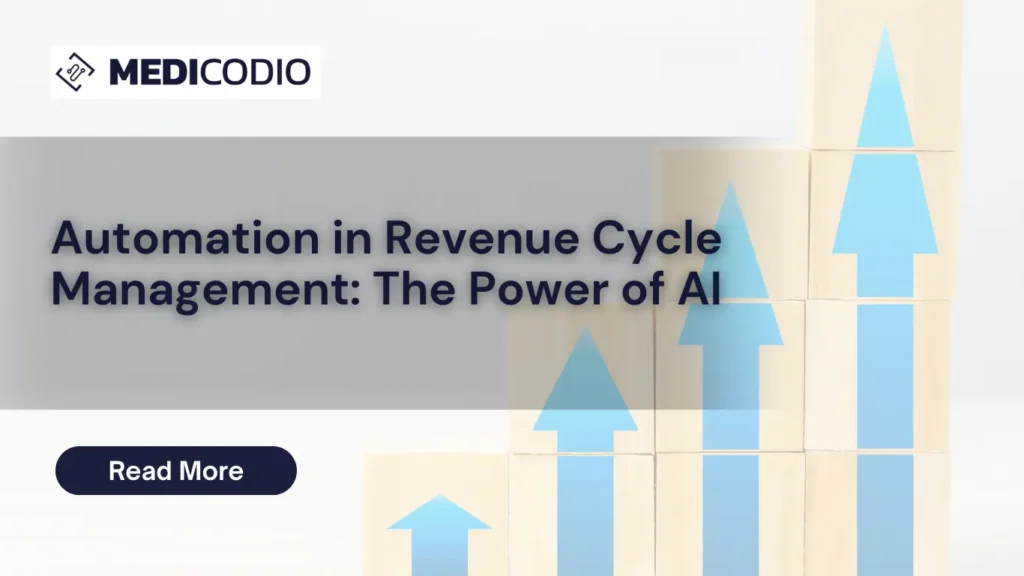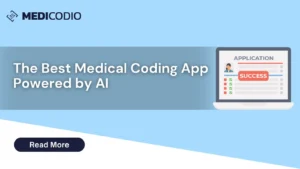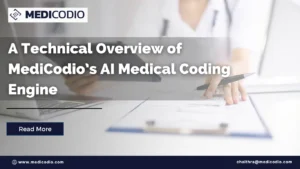Table of Contents
Automation in Revenue Cycle Management (RCM) has taken a giant leap forward. According to a recent survey by HFMA in 2023, 74 percent of RCM companies have already automated most aspects of RCM operations. These companies have witnessed significant growth by automating the entire RCM process. By looking at the positive impact of AI automation in Revenue Cycle Management process, software developers have gone one step further. They have integrated RPA with generative AI to reap more benefits from these technologies.
In this article, we’ll explain how AI in RCM is helping RCM leaders and healthcare coding & billing managers achieve greater savings and improved efficiency.
What is Automation in Revenue Cycle Management?
Automation in Revenue Cycle Management refers to using technology and software solutions to streamline and optimize the financial processes within healthcare organizations. Tasks that were done manually are now being done automatically with little human intervention. This includes automating tasks such as patient registration, appointment scheduling, medical coding, claims processing, billing, and payment collections. Automation in Revenue Cycle Management aims to reduce manual intervention, minimize errors, improve efficiency, and ultimately enhance the overall revenue cycle performance. By leveraging automation technologies such as robotic process automation (RPA), machine learning algorithms, and Natural language processing (NLP), healthcare providers can automate repetitive and time-consuming tasks, leading to cost savings and faster revenue realization.
One key aspect of Automation in Revenue Cycle Management is improving data accuracy and consistency. By automating data entry, validation, and reconciliation processes, healthcare organizations can reduce errors associated with manual data handling. This not only ensures compliance with regulatory requirements but also facilitates better decision-making through access to accurate and reliable financial data. Additionally, Automation in Revenue Cycle Management enables real-time monitoring and analysis of revenue cycle metrics, allowing organizations to identify bottlenecks, implement proactive measures, and optimize revenue generation strategies. Overall, Automation in Revenue Cycle Management is crucial in enhancing operational efficiency, financial performance, and patient satisfaction in healthcare settings.
Types of Automation in Revenue Cycle Management?
The automation in RCM utilizes RPA, Machine Learning, NLP, and optical character recognition (OCR) to streamline the entire RCM process from patient registration to reimbursement.
Healthcare facilities often deal with complex paperwork, which can be a huge burden on their staff. To simplify this process, Optical Character Recognition (OCR) technology has become a valuable tool for document departments. OCR allows computers to read the text in images or scanned documents. This technology has several functions, one of which is the ability to generate an invoice from a scanned medical record. This eliminates the need for repetitive data entry, saving time and reducing errors.
-
- Robotic Process Automation (RPA): RPA streamlines repetitive tasks such as data entry, claims processing, and billing verification. It reduces errors, accelerates workflows, and enhances overall operational efficiency by automating mundane tasks, allowing healthcare professionals to focus on more strategic activities.
- Machine Learning (ML): ML algorithms analyze large datasets to identify patterns and trends, enabling predictive analytics for revenue forecasting, identifying potential fraud, and optimizing reimbursement strategies. ML also improves coding accuracy and assists in identifying coding discrepancies.
- Natural Language Processing (NLP): NLP understands and processes human language, facilitating automated analysis of unstructured clinical notes, billing documents, and patient records. It improves coding accuracy, speeds up claim submission processes, and enhances documentation completeness for compliance and audit purposes.
- Optical Character Recognition (OCR): OCR technology converts scanned documents and images into machine-readable text, enabling automated data extraction from invoices, EOBs (Explanation of Benefits), and other financial documents. It reduces manual data entry errors, accelerates payment posting, and improves claims processing efficiency.
These technologies collectively contribute to a more streamlined and accurate RCM process, leading to improved revenue capture, reduced administrative burden, and enhanced financial performance for healthcare organizations.
The Power of RCM Automation
Undoubtedly, the future of healthcare RCM is powered by innovative technologies. According to McKinsey’s study, in the healthcare industry, technology-driven innovation has the potential to improve patient care and create $350-410 billion in annual value by 2025. Another survey conducted by the 2023 National Association of Healthcare Revenue Integrity reported that 73 percent of the respondents were happy with the automation and experienced a positive impact on their revenue.
As per the Healthcare Financial Management Association’s (HFMA) survey, 20 percent of the respondents agree that automation in revenue cycle management speeds up basic functions and improves efficiency.
This article by MediCodio explains the satisfaction level of AI in medical coding.
The transformative potential of RCM automation is evident through studies and surveys that demonstrate its ability to enhance patient care, generate substantial value, and improve revenue management efficiency. With technology-driven innovation at the forefront, healthcare organizations are experiencing positive outcomes, as indicated by high satisfaction rates and increased efficiency reported by industry experts and surveys. As we look to the future, the integration of AI and automation in medical coding promises to further elevate the standards of healthcare revenue cycle management, marking a pivotal shift towards a more streamlined and effective healthcare ecosystem.
Application of AI in RCM process
AI in RCM plays a crucial role in streamlining and enhancing various aspects of the Revenue Cycle Management (RCM) process. Here are some key applications of AI in RCM:
Claims Processing Optimization: AI-powered algorithms can analyze historical claims data to identify patterns, predict claim denials, and suggest corrective actions. This helps in reducing claim rejections, accelerating reimbursement cycles, and improving revenue capture.
Predictive Analytics for Revenue Forecasting: AI and machine learning models can analyze diverse datasets including patient demographics, payer trends, and billing patterns to forecast future revenue streams. This enables healthcare organizations to make informed decisions regarding resource allocation and financial planning.
Automated Medical Coding: AI automation plays a pivotal role in revolutionizing medical coding processes within healthcare organizations. Traditionally, medical coding has been a labor-intensive and error-prone task, requiring skilled coders to manually review patient records and assign appropriate diagnosis and procedure codes. However, AI automation streamlines this process by leveraging natural language processing (NLP) and machine learning algorithms to analyze clinical documentation and automatically generate accurate codes.
One of the primary ways AI automation aids in medical coding is through the extraction of relevant information from unstructured clinical notes, such as physician dictations or electronic health records (EHRs). NLP algorithms can parse through these textual documents, identifying key clinical terms, diagnoses, procedures, and other relevant information. By understanding the context of the documentation, AI algorithms can then suggest or automatically assign appropriate medical codes, significantly reducing the time and effort required for manual coding.
Moreover, AI automation in medical coding improves accuracy and consistency by minimizing human errors and discrepancies. Machine learning models can be trained on vast amounts of labeled data to recognize patterns and relationships between clinical terms and corresponding codes. Over time, these models become increasingly proficient at accurately assigning codes, thereby reducing the risk of coding errors, claim denials, and compliance issues.
Furthermore, AI automation enables real-time feedback and coding validation, allowing coders to receive instant alerts or suggestions for potential coding inaccuracies or documentation deficiencies. By providing timely guidance and support, AI algorithms empower coders to make informed decisions and ensure compliance with coding guidelines and regulations.
Overall, AI automation enhances the efficiency, accuracy, and compliance of medical coding processes, enabling healthcare organizations to streamline revenue cycle operations, optimize reimbursement, and improve financial performance.
Patient Eligibility Verification: AI-powered solutions can automate the verification of patient insurance eligibility and coverage details. This ensures that services rendered are covered by insurance, reducing claim denials and improving revenue cycle efficiency.
Automation of Administrative Tasks: AI and robotic process automation (RPA) can automate routine administrative tasks such as appointment scheduling, billing inquiries, and payment posting. This frees up staff time, reduces manual errors, and improves overall operational efficiency.
Revenue Leakage Prevention: AI can analyze billing and financial data to identify areas of revenue leakage such as undercoding, missed charges, and payment discrepancies. By proactively addressing these issues, AI helps maximize revenue capture and optimizing revenue integrity.
Payer contract analysis and reporting: AI automation plays a crucial role in streamlining payer contract analysis and reporting within Revenue Cycle Management (RCM) by leveraging advanced analytics and machine learning algorithms. Firstly, AI automation enables healthcare organizations to efficiently analyze complex payer contracts by extracting key terms, clauses, and reimbursement rates from contractual documents. Natural language processing (NLP) techniques can automatically interpret and categorize contract language, identifying relevant provisions such as payment terms, fee schedules, and performance metrics.
Overall, AI empowers healthcare organizations to optimize revenue cycle processes, reduce operational costs, mitigate risks, and enhance the financial performance of healthcare providers.
What is Generative AI in Revenue Cycle Management?
Generative AI in Revenue Cycle Management (RCM) refers to the application of artificial intelligence techniques to generate data or content that is relevant to optimizing revenue cycles within the healthcare industry. In the context of RCM, generative AI can be utilized to produce realistic simulations of billing scenarios, patient encounters, or financial forecasting models. By leveraging generative AI, healthcare organizations can create synthetic data sets that closely mimic real-world situations, enabling them to train and refine their RCM systems without relying solely on limited historical data. Additionally, generative AI can be employed to automate the generation of personalized patient communication materials or financial reports, streamlining administrative tasks and improving operational efficiency within revenue cycle processes.
Generative AI in RCM represents a departure from traditional AI approaches in several key ways. Unlike traditional AI, which often relies on large volumes of historical data to make predictions or decisions, generative AI can generate new data points based on patterns and structures learned from existing data. This ability is particularly advantageous in industries like healthcare, where data may be scarce or sensitive. Furthermore, generative AI fosters creativity and innovation by producing novel solutions and insights that may not have been evident from historical data alone. However, it also poses unique challenges, such as ensuring the ethical use of synthetic data and maintaining the reliability and accuracy of generated content in critical decision-making processes.
Ready to Jump into the AI bandwagon?
Are you hesitating on the brink of deploying AI for your Revenue Cycle Management (RCM) processes? It’s understandable; embracing new technologies can be daunting, especially in critical areas like healthcare finance. However, consider this: automation and AI have the potential to revolutionize RCM, streamlining operations, reducing errors, and improving financial outcomes. Now might be the perfect time to leap onto the AI bandwagon.
By embracing automation in your revenue cycle management processes, you can unlock efficiencies, uncover insights, and stay ahead in an increasingly competitive landscape. So, why wait? Seize the opportunity to optimize your RCM workflows and propel your organization into the future of healthcare finance.
Benefits of AI in Revenue Cycle Management
AI automation offers a plethora of benefits in Revenue Cycle Management (RCM), transforming the efficiency and effectiveness of financial processes within healthcare organizations. Firstly, AI automation significantly reduces the manual workload associated with tasks such as medical coding, billing, and claims processing. By automating these repetitive and time-consuming tasks, healthcare providers can reallocate staff resources to more complex and value-added activities, thereby enhancing productivity and reducing operational costs.
Moreover, AI automation enhances the accuracy and consistency of RCM processes by minimizing human errors and discrepancies. Machine learning algorithms can analyze vast amounts of data to identify patterns and trends, leading to more precise coding and billing practices. This not only improves revenue capture but also reduces the risk of compliance violations and billing inaccuracies, ultimately safeguarding the financial health of the organization.
Additionally, AI automation facilitates faster decision-making and revenue cycle optimization through real-time data analytics and predictive modeling. By leveraging historical data and predictive algorithms, healthcare providers can proactively identify potential revenue leakage points, anticipate payment delays, and implement targeted interventions to accelerate cash flow and minimize revenue cycle disruptions.
Furthermore, AI automation enhances the patient experience by enabling personalized communication and engagement throughout the billing and payment process. By leveraging natural language processing and chatbot technology, healthcare organizations can deliver tailored billing statements, payment reminders, and financial counseling services, thereby improving patient satisfaction and loyalty.
Overall, AI automation in Revenue Cycle Management holds the promise of streamlining operations, enhancing accuracy, enabling proactive decision-making, and ultimately improving financial outcomes for healthcare providers. If you are looking to optimize one of the crucial aspects of the RCM process – medical coding, MediCodio is your go-to partner.
Don’t let manual coding slow you down. Discover how automation can revolutionize your revenue cycle. Schedule a demo to see how CODIO, an AI medical coding tool works and see the future of medical coding!





